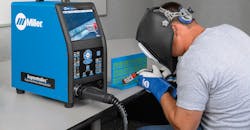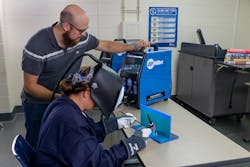Fusing the Skills Gap with Augmented Training
Augmented Reality can breathe life into the fantastical, conjuring monsters and magic right before your eyes, or imbue you with precognitive abilities, letting you glimpse what your factory floor would look like with a new 10-ton turbine. Basically, AR blurs the line between the cold, hard physical world you're used to and the video game world you want to escape to.
As such, AR could become the premier training tool for hazardous jobs, from the military to aviation to industrial trades. The experience is wholly immersive while remaining safe and requires only the hardware, such a smart glasses, and software, to manifest it. No fuel is spent; no trainee is injured.
These are a few of the driving forces behind the latest welding training simulator from Miller Electric Mfg. Co. Called AugmentedArc, this AR welding system uses equipment that looks very much like the real thing, from the welding helmet to the gun, and replicates the real experience of performing a MIG, TIG, FCAW, or stick weld. The welding helmet is actually a smart helmet with a heads up display and speakers, so green and blue plastic looks like a metal coupon, and makes it appear as if the camera-tipped gun really emits a welding arc.
Photo: Miller
The major difference is a screw-up on this machine means you simply reset, like in a video game. The instructor can load a program, and if your angle and technique aren't correct for a butt weld or lap joint, for instance, the display indicates the discrepancy so you can course-correct. The instructor can also see the student's POV on the machine in real time, or go back and analyze later and create progress reports.
Screengrab: Miller/ Youtube
In a live welding booth, a mistake could ruin your steel coupon (the metal practice piece), waste gas or wire, or the worst case scenario, cause serious injury. For the vocational school, union facilities, or manufacturer running the training program, saving money is obviously enticing. But its true value lies in its power to attract the next generation to welding, says Miller product manager Steve Hidden.
"The next generation is learning differently," he says. "Everything is electronic, from phones to media. The attractiveness of innovative tech needs to be utilized if we're going to attract people to the trades."
And getting young people to the trades is more important than ever. By the end of the decade, manufacturers, who provide about 60% of all welding jobs, will need almost 300,000 new and replacement welders, according to the American Welding Society.
"We've been manufacturing welding equipment for 85 years, so we're connected to the industry and realize the importance of the health of the industry," Hidden says. "As we are out engaging our customers, the lack of skilled welders is very evident."
Once Miller identified this gap, they began investigating AR about three years ago, and released the $20,000 AugmentedArc last September.
Click HERE to find out more information on the AugmentedArc.
A Miller-supplied case study of the technology for welding training shows just how strongly students have bonded to the simulator. Students have tripled the number of correct welds completed in the welding booth. Their workshop time required to achieve course objectives has dropped by more than 60%. Consumable usage (sticks, plates, etc.) has also been reduced by more than 60%, as well.
"It pays for itself very quickly when you look at the increased class capacity and success rate when students get into booth," says Jake Cayson, a salesperson for Daktic, an industrial training equipment distributor for Idaho and Montana that sells the training system. "AugmentedArc speeds up the training process significantly, so you're able to get a much larger number of students through with a smaller lab."
The Miller-certified trainer explains in a lab scenario, a student may have to wait several minutes for the instructor to check the weld, and the teacher can only guess how the weld was achieved.
"In contrast, students are now able to sit by themselves, do 50 welds instead of one or two, and they will be way ahead of the curve when they get into the real thing," Clayson says. "They've developed the necessary muscle memory and conceptual skills before they even set foot in the booth."
Miller recommends this AR for beginner and intermediate-level welders, though Clayson says schools aren't his only clients.
"Even if you're experienced welder, with certain positions and certain welds there's a lot to be mastered," he says. "One of our clients is a power plant that bought it because even though they have experienced welders, they can’t afford to have them practice on real thing."
Teachers can come up with all sorts of quizzes and scenarios using the Instructor software, so most welders can pick up some new techniques. The main issue is getting instructors acclimated to the new technology. Someone who grew up with the frenetic chaos of "Call of Duty" on a widescreen TV will feel right at home, but an aging instructor who can remember life before "Pong" might need a few days to get used to the sensory changes.
"They may fail a basic mid-weld, and that for them is often a stumbling block," Clayson says. Students, however, have shown to pick it up quickly.
Instead of worrying about a human instructor coming down on them for messing up, or fighting the trepidation about burning off some forearm flesh, beginner students can work on refining their technique with the gentle, immediate guidance of the simulator.
"It could be intimidating to enter the booth with some gruff pipeline veteran," Clayson acknowledges. "This decreases anxiety that can be an impediment to learning."
And making welding inviting and attractive to all, and showing that it's a technical skill anyone can learn, is really the point.
Welders make a median salary of around $37,000, and some underwater welders can make up to $300,000. It's a strong career field that will need bodies soon, and doesn't take a four-year degree that costs as much as a house.
"We're looking for qualified welders," Hidden says. The lack is because people think it is a dirty job. There's so much more than the dirty side of it."
Already it appears this tool is helping destroy long-held stereotypes.
Photo: Miller
"We did training where one of the girls got an almost perfect score," Clayson recalls. "She played video games quite a bit."
And that may be the easiest solution to this impending dearth of talent.
"If we can double the candidates for this sort of career, that's a real benefit for bridging that gap," Clayson says.
About the Author
John Hitch
Editor, Fleet Maintenance
John Hitch, based out of Cleveland, Ohio, is the editor of Fleet Maintenance, a B2B magazine that addresses the service needs for all commercial vehicle makes and models (Classes 1-8), ranging from shop management strategies to the latest tools to enhance uptime.
He previously wrote about equipment and fleet operations and management for FleetOwner, and prior to that, manufacturing and advanced technology for IndustryWeek and New Equipment Digest. He is an award-winning journalist and former sonar technician aboard a nuclear-powered submarine where he served honorably aboard the fast-attack submarine USS Oklahoma City (SSN-723).




